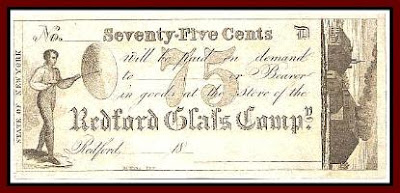We’ll begin with a product familiar to many people in this region: Redford Glass. Although the Redford Crown Glass Company was in business for a relatively short period of time (between 1831 and 1851) and only about 250 pieces made there have been definitively identified, it played a very important role in the development of the American glass industry and the economy of northern New York.
 |
| Two Redford Glass jugs |
Construction of the glassworks began in March 1831, and the first glass was produced in October 1831. Redford’s main product was window glass—the factory produced about 10,000 boxes of window glass annually during the 1830s, and it was used all over the country, including many of the public buildings in Washington, D.C. According to an article in the Plattsburgh Republican, Redford Glass was “capable of standing every variety of climate” and was “distinguished from the ordinary crown glass by its uncommon clearness and beauty of surface, its superior transparency and lightness of color, and by its great thickness and general excellence of the materials which compose it.”
 |
| Redford Glass pitcher with lily-pad decoration |
Redford Glass pieces employed two distinctive forms of ornamentation. One type was known as “threading,” and was created by winding thin strands of glass around the object, usually to decorate the neck or rim of a drinking vessel. The other was called the “lily-pad” and was made with a droplet of molten glass that was pulled across the surface of the object.
 |
| Scrip issued by Redford Glass Co. for use at company store |
Today, Redford glass stands as a memento of northern New York’s early industrial history, and pieces of Redford glass are treasured items in private and public collections, including the Clinton County Historical Association and the Plattsburgh State Art Museum.
The information in this post is taken from Reflections: The Story of Redford Glass, the catalog of an exhibition held at the Clinton County Historical Association in 1979, which is available to purchase from CCHA.


did redford glass have a inscription on the lily vase
ReplyDeleteAs far as I'm aware, Redford glass pieces were not marked in any way!
ReplyDelete